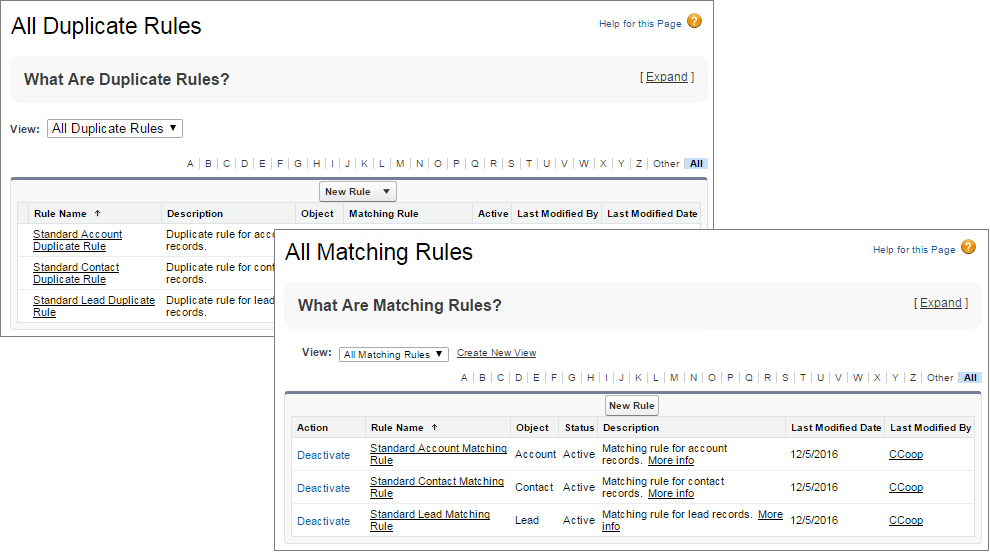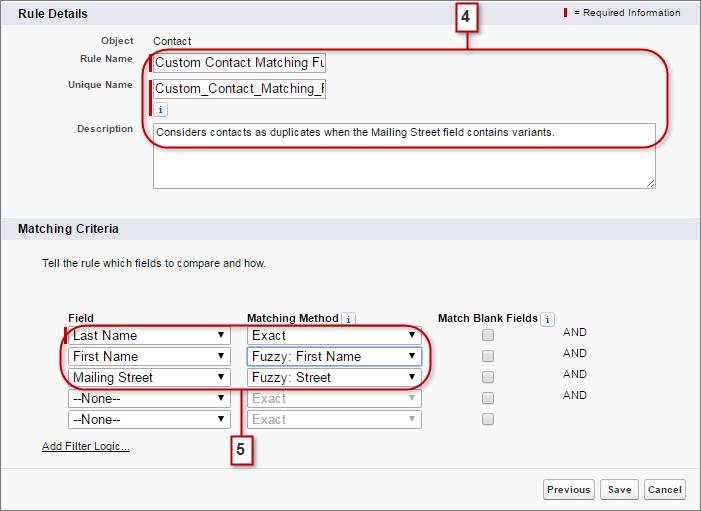Resolve and Prevent Duplicate Data in Salesforce
Learning Objectives
After completing this unit, you’ll be able to:
- Explain the difference between matching rules and duplicate rules.
- Identify features of standard matching rules.
- Discover options for customizing matching rules.
- Create matching rules.
Rules for Duplicate-Free Data
Matching rules and duplicate rules work together to ensure that your sales teams work with data that’s free of duplicates. Before your reps save new and updated records, matching rules and duplicate rules provide warnings of potential duplicates. You manage matching rules and duplicate rules in Setup.

But what’s the difference between matching rules and duplicate rules?
Matching Rules
Let’s look at how matching rules work in Salesforce.
We developed our standard matching rules to return the best possible set of match candidates for business accounts, contacts, leads, and person accounts. Here’s an example of some of the matching criteria we include for contact and lead records.
Contact and Lead Field |
Matching Algorithms |
Special Handling |
Example |
|---|---|---|---|
First Name |
|
If the record contains a value for both First Name and Last Name fields, those values are transposed to consider possible data entry mistakes. |
The first name is Luis and the last name is Antonio. The matching rule evaluates the first name as Antonio and the last name as Luis. |
Title |
|
Considers acronyms and full titles. |
The title is VP. The matching rule considers VP and Vice President. |
Mailing Street |
|
Addresses are broken into sections and compared with those sections. Each section has its own matching method and match score. The section scores are weighted to determine one score for the field. This process works best with North American data.
|
Duplicate Management compares these two addresses.
Only the street number and street name match. The field has a match score of 70 out of a possible 80. This comparison isn’t a match. |
We also give you other ways to identify duplicates. For example, some of your contacts include phone numbers with country codes. So you create a custom matching rule to include fuzzy matching for phone numbers. Salesforce flags contacts with matching phone numbers as duplicates, even though one includes a country code and the other doesn’t.
Activate a Matching Rule
We provide standard matching rules for you. If you established your instance of Salesforce for Winter ’15 or earlier, like Maria, you activate the standard rules you want to use. Maria, however, wants to activate standard rules for only accounts and leads. She has other plans for her contacts, which we cover after this procedure.
- From Setup, Maria enters Matching Rules in the Quick Find box, then selects Matching Rules.
- She clicks Activate next to the rules for accounts and leads.

Easy!
Create a Custom Matching Rule for Contacts
For contacts, Maria wants to include fuzzy matching for the Mailing Street field.
And instead of letting sales reps create the duplicates, she wants to block them from doing so, which we cover after this procedure.
- From Setup, Maria enters Matching Rules in the Quick Find box, then selects Matching Rules.
- She clicks New Rule.

- Maria selects Contact.

- She gives the rule a descriptive name, Custom Contact Matching Fuzzy Mailing Street. She also adds a description so that other admins understand its value.

- Maria adds the matching criteria, then saves her matching rule and activates it.

Block Duplicates with Fuzzy Mailing Streets
Now let’s learn more about using duplicate rules to manage records.
After matching rules do the work of identifying potential duplicates, duplicate rules step in and determine what to do with them. As the admin, you choose whether to block your sales teams from creating duplicate records.
Let’s say you let reps create duplicate records. You can create report types that show potential duplicate records created after your reps bypass warnings. We talk about these reports more a bit later.
Before an active matching rule can do anything, you pair it with a duplicate rule. You can include up to three matching rules in each duplicate rule, and up to five active matching rules per object.
Maria wants to prevent sales teams from creating duplicates when the Mailing Street field includes variants, such as SW Barnes Ave and Southwest Barnes Avenue.
- From Setup, Maria enters Duplicate Rules in the Quick Find box, then selects Duplicate Rules.
- She clicks New Rule and selects Contact.

- Maria gives the duplicate rule a name and description.

- She blocks the creation of duplicates. She also blocks her teams from editing contacts that result in duplicates.

- She compares the new or updated contact with contacts already in Salesforce using the custom matching rule she created earlier. Then, she saves her duplicate rule and activates it.


Report on the Creation of Duplicate Accounts and Leads
Maria doesn’t block reps from creating duplicates for accounts and leads. So Lincoln wants to see the quality of account and lead data and how well the duplicate rules work. To help Lincoln, Maria sets up custom report types. Lincoln can then run reports on accounts and leads that his reps create after bypassing the warnings of creating potential duplicate records.
- From Setup, Maria enters Report Types in the Quick Find box, then selects Report Types. She then clicks New Custom Report Type.
- She selects the primary object, Accounts. She gives the report type a name and stores it in a category.

- Maria selects Duplicate Record Items, so that newly created duplicate account records appear on the report. Then, she saves the report type.

- From here, Maria can adjust the page layout. Then, she repeats this procedure for leads.

Creating an environment free of duplicates keeps your sales teams on their A-game, and sales management informed on the quality of their data.
Resources
Use these resources to learn more about matching rules and duplicate rules.
-
Salesforce Help: Standard Matching Rules
-
Salesforce Help: Standard Duplicate Rules
-
Salesforce Help: Customize Matching Rules
-
Salesforce Help: Matching Rules
-
Salesforce Help: Duplicate Rules
